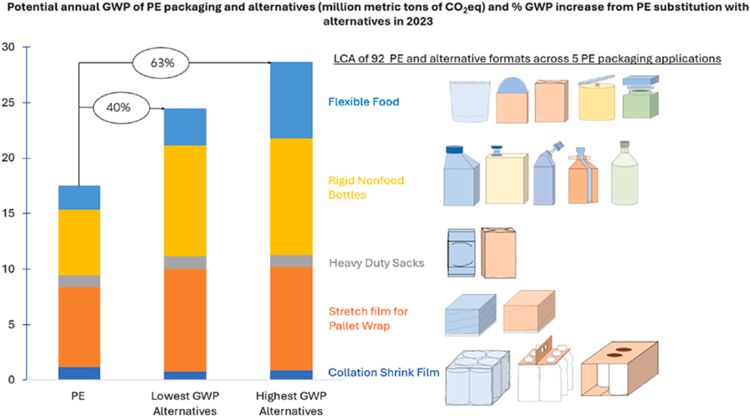Plastic packaging plays a critical role in preserving and protecting goods across value chains, including transportation, storage, marketplace, and consumption. However, growing concerns about potential environmental impacts such as life cycle emissions and plastic pollution have prompted reassessments of packaging materials. This study focuses on polyethylene (PE), the most used packaging polymer on the European market, with an annual sales volume of 4.85 million metric tons in 2023, examining its potential environmental impacts and that of alternatives such as paper, metals, and glass. The main objective of this study was to assess the potential climate change, water scarcity, and fossil resource use impacts for single-use PE packaging applications versus alternative packaging solutions within the European market. Given its comparative nature, this LCA study has followed ISO 14040:2006 and ISO 14044:2006 requirements and attributional LCA principles. Thirty-seven products packaged with PE formats and their alternatives across five end-use applications (stretch films, collation shrink films, rigid non-food containers, heavy-duty sacks, and flexible food packaging) were compared in the European markets. The assessment covered the material and production phase to end-of-life (EoL), based on current conditions in Europe (EU27 + UK). The potential impacts from the packaged product's production and usage phase were excluded. Packaging was assessed by the volume or weight of its contents, with high market share samples sourced mainly from Austria and Germany. EoL modeling followed the Circular Footprint Formula, incorporating standard disposal rates. Comparative analysis used published data on packaging and PE markets to model potential scenarios, demonstrating the life cycle GWP impacts of substituting PE-based packaging with alternatives. Results indicated that PE packaging had a lower GWP impact than steel, aluminum, and glass in 15 out of 15 comparisons. Against paper and multi-material alternatives, PE-based options were more favorable in 19 out of 35 cases, with paper alternatives being more favorable in 13 instances and three comparisons showing minimal difference – less than 10 %. PE-based packaging exhibited lower GWP in 68 %, higher GWP in 26 %, and negligible differences in 6 % of 50 LCA comparisons of PE-based packaging and alternatives. Scenario analyses suggested that substituting PE with alternatives could increase GWP from 17.5 MTA CO2-eq to between 24.5 and 28.7 MTA CO2-eq, marking a 40 %–64 % rise. The mass of packaging materials could rise from 4.85 MTA for PE to between 16.70 and 19.97 MTA (244–306 %) for alternatives, emphasizing the significant mass reduction advantage of PE-based packaging.




